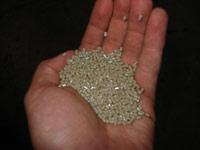Choosing a Thermoset or Thermoplastic Resin for a Composite Sandwich Panel
Most composite sandwich panels are composed of a core (foam, balsa, honeycomb, etc.) and structural skins. Composite skins, like most composites, are comprised of two parts: a structural fabric, and a resin matrix holding the fabric together. Structural fabrics are made up of miniature fibers that are woven or stitched together. These fabrics are generally made of graphite/carbon fiber, aramid fiber such as Kevlar, or the most common fiber used today… glass.
Glass fiber is strong, lightweight, and when bundled up with thousands of other tiny glass fibers, it is incredibly strong. However, this fabric alone is not stiff or sturdy enough to support loading requirements. In order for the sandwich panel to be truly effective, the fabric skins must be “impregnated” with a resin matrix.
Resins for composites can be broken down into two major categories, thermoset and thermoplastic. Thermoset resins generally come in liquid form, and when mixed with a catalyst, a chemical reaction occurs forming a solid. Thermoset molecules crosslink with each other during curing, thus once cured, they cannot change. Below are features of thermoset resins.
Thermoset Resin:
Pros
Easy to process and laminate
Does not necessarily need pressure or heat to form
Generally inexpensive
Generally stronger than thermoplastics
Generally better suited to higher temperatures then thermoplastics
Cons
Often release emissions known as volatile organic compounds (VOCs)
Cannot be recycled or reclaimed easily
Short workable pot life, with some exceptions
Less-than-perfect surface finish
Common Types of Themoset Resins
Epoxy
Polyester
Vinylester
Polyurethane
Phenolic
Thermoplastic resins have molecules that are generally not crosslinked, meaning, the resin can be repeatedly melted and reused. Usually, no chemical change occurs when thermoplastic is cured. Thermoplastic resin usually starts out in solid pellet form, and changes shape with the addition of heat and pressure. Below are features of thermoplastic resins:
Thermoplastic Resin

Pros
High Impact Strength
Attractive Surface Finish
Recyclable / Scrap is Reusable
No Emissions
Can bond to other thermoplastics
Can be molded or shaped with reheat
Cons
Generally softens with heat
More difficult to prototype
Common types of Thermoplastic Resins
Polyamide (PA or Nylon)
Polybutylene terephthalate (PBT)
Polyethylene terephthalate (PET)
Polycarbonate (PC)
Polyethylene (PE)
Polypropylene (PP)
Polyvinyl chloride (PVC)
Related Articles:
The Sandwich Panel Core
Safety Working with Composites
Composite Sandwich Video Archive
Learn more about thermoplastic and thermoset resin:
Plastic Industry.org
Plastiquarian.com
IDES.com
Home - Archive - Resources - Contact